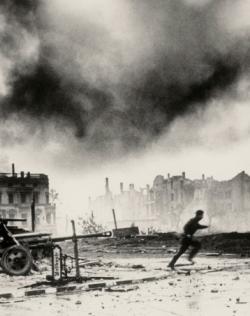By John Pickard
The best Marxist analysis of the rise of Nazism in the inter-war years is undoubtedly contained in the writings of Leon Trotsky. He did not merely condemn the inhumanity and the barbarism of German fascism, but he analysed Hitler’s rise from the point of view of the class struggle and the interplay of social and class forces in society, including the failures of the leadership of the workers’ movement.
Heinz Rein’s novel, Berlin Finale, newly-translated into English, is a good complement to the writings and analysis of Trotsky and is worth reading alongside. The entire book is set in two weeks towards the end of April 1945 and is an excellent fictionalised account of the privations and hardships faced by the civilian population as American and British bombing gradually reduce Berlin to a sea of rubble in the last days of the war.
Rein describes graphically how hundreds of thousands of the still very large Berlin population spent their nights, and sometimes the days, cowering in shelters and cellars as the world above their heads was blasted by thousands of tonnes of high explosives.
Writing from direct experience
From Rein’s account you can almost smell the shattered landscape of Berlin – a sea of debris, ash, smoke, ruin, broken glass, twisted metal, sooty, splintered bits of furniture, broken bricks and the gaping ruins of houses and offices. This book, first published in the East German Democratic Republic in 1949, was probably the best example of what became known as “rubble literature“ (trümmerliteratur).
Heinz Rein wrote from experience: he lived through the events he fictionalised in his book. He was originally a journalist, but after the Nazis came to power in 1933, he was banned from professional writing because of his views. He was subsequently forced to work on the German rail network, where he spent the greatest part of the war, although he too, like the characters in his book, had spells in Gestapo detention.
After the war, he worked for what became the East German Cultural Advisory Board for Publishing and it was during that time that he completed his book, publishing it in 1947. At one time, the East German Stalinist government suppressed the sales of the book, when it had received some negative reviews from ‘on high’. He eventually moved to West Germany around 1952, where he lived until his death in 1991.
Hiding in plain site from the police and the state
The main characters in Berlin Finale are members of an anti-Nazi resistance group, extremely small in number and living under the constant threat of arrest, torture and execution. Some of these are former trade unionists, socialists or communists, having had spells in and out of prison camps. Many are living ‘underground’ with false papers and identities, including deserters from the army, hiding in ‘plain sight’ from the police and the state.
Other characters are members of the Nazi Party and Rein describes how their despair and personal and political failings had led them to embrace Hitler’s movement. Bullies, thugs, misfits, petty-criminals, bankrupts and all kinds of lumpen-proletarians were fodder for the propaganda of the Nazis and the SA, and many of them quite naturally ended up wearing the brown shirt: still bullies and thugs, but now with the sanction of state power behind them. Rein outlines the biographies of some of these riff-raff and his descriptions are a good complement to the insightful analysis of Marxists like Trotsky.
Propaganda department functioned to the end
What also comes across is the absolute ruthlessness of the Nazi state machine, even when it was clear to anyone with half a brain that the war was lost. Russian tanks were only a dozen miles to the East and the Western Allies fifty or sixty miles to the West of Berlin, but the propaganda department of the Reich still churned out newspapers and broadcasts on a daily basis, reassuring the population that “all will be well” and that the Fuhrer would win through.
Many Germans still believed this, habituated as they were to the gigantic weight of Nazi propaganda, day-in and day-out, for twelve years. The other significant factor keeping the population in line was sheer terror. Nazi proclamations demanded that the entire population fight “to the death” and behind their exhortations there was the ever-present threat of the Gestapo and SS. Even on the very brink of a disastrous defeat, the regime of Nazi terror did not let up for a moment. Deserters, ‘idlers’, ‘doom-mongers’, dissidents, anyone not prepared to put in time to dig trenches in the street, were liable to be strung up by the SS on a lamp-post, provided that was, that a standing lamp-post could be found.
“Their power is still stretched around everyone…”
“Even though the whole edifice of the state is shaking and tottering and Party, Gestapo and Wehrmacht are all writhing in agony under the annihilating blows of a superior adversary,” Rein writes, “their power is still stretched around everyone like a ring of steel. The fear of terror is still great enough to give every threat the desired intensity, every order unconditional obedience. Behind everyone there still stretches the black shadow of the SS, the horror of the concentration camps and the death sentences of the People’s Courts.”
As the book moves to its denouement, we see Russian tanks drawing ever nearer to central Berlin, while the oppositionists actively seek to surrender to the Red Army, at the same time having to dodge the SS patrols who were still fanatically demanding resistance. Berlin Finale might be a somewhat sombre book, but as a piece of modern political literature, it is a masterpiece and well worth the read.
February 26, 2020



